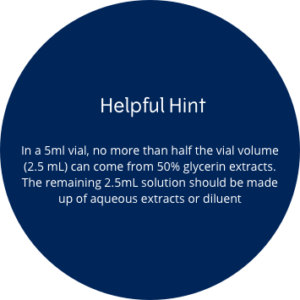Extract Formulations
Allergen extracts are available in a variety of formulations. An extract’s formulation directly impacts the stability of the allergenic proteins in solution and therefore the shelf life of the product. The FDA has determined maximum expiration dates for each formulation based on the estimated loss of potency over time. All extracts can be expected to lose some potency even if stored and handled properly prior to the assigned expiration date.
Due to this gradual loss of potency over time, for patient safety, we recommend performing a dose adjustment whenever switching to a new lot or vial. Many practices employ a 50% dose reduction when administering the first dose from a new vial. However, if a patient is highly sensitive, they may require an additional reduction.
Aqueous allergenic extracts are formulated in a buffered solution of sodium chloride (0.9%) with phenol (0.4%) as a preservative. Aqueous extracts have a limited stability profile and receive a maximum of 18 months expiration dating. Phenol is a bacteriostatic agent that is required by the FDA in aqueous extracts to inhibit microbial growth.
Glycerin:
Glycerinated allergenic extracts are formulated in a solution of sodium chloride (0.9%) and 50% glycerin by volume. Glycerin (or glycerol) is a viscous alcohol derivative that promotes protein stability by slowing thermodynamic degradation and inhibiting enzymatic activity and microbial growth. The FDA defines glycerin concentrations below 50% as aqueous formulations. Glycerinated extracts receive a maximum shelf life of 36 months (3 years) due to their enhanced stability profile compared to aqueous extracts. Since glycerin is thick and viscous, at high concentrations it can produce irritation upon injection. Data has shown that a final glycerin concentration of 25% is tolerated by most immunotherapy patients.
Lyophilized (Freeze-dried):
Freeze-dried allergenic extracts are in a powdered formulation that must be reconstituted prior to use. The freeze-drying process removes water from the extract solution, which leads to greater stability and a longer shelf life than what is achieved with liquid extracts (up to 5 years if not reconstituted and refrigerated). Once reconstituted, the extract will have an aqueous shelf life of 12 months. Currently, the Hymenoptera Venom extracts are the only products available in the freeze-dried formulation.
Alum-precipitated extracts represent a unique product formulation that combines an aqueous allergenic solution with an aluminum (alum) salt to create an insoluble matrix of absorbed allergen proteins. Alum- precipitated extracts are considered aqueous formulations for the purpose of expiration dating and therefore receive the same shelf life as aqueous products. The alum serves as an adjuvant which enhances the immune response while also delaying and prolonging allergen absorption during immunotherapy. This slow release, or depot, effect leads to fewer reactions in highly sensitive patients. Currently, ALK is the only supplier of alum-precipitated extracts in the US.
For more information, see the following sections:


